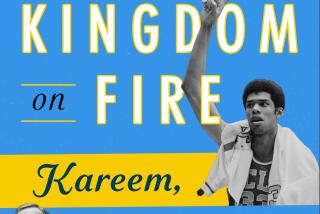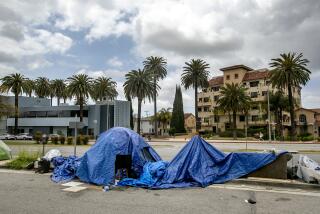John Wayne: He Found His Home Base
- Share via
Michael Marion Morrison--better known to a few billion people as John Wayne--and Orange County had to find each other. It took a while.
Wayne was 58 when he moved from Encino to the Bay Shores Estates home in Newport Beach where he spent the rest of his life. But when a reporter asked him a few years later where he would live if he had a choice of anywhere in the world, he answered without hesitation, “I’m living there.”
He did too. The things that made him most comfortable and pleasured him most, he found in his Orange County home. The sea, and a place to dock his beloved boat. Warm cronies. Conservative political environment. Good schools for his children. A home base he could come back to gratefully from movie locations.
Wayne lived in Orange County. He shopped in its stores, walked along its streets, dined in its restaurants and involved himself--when he was so moved--in its social and political life. “People around home don’t hassle me,” he once told me. “They mostly respect my privacy. I don’t restrict my movements around here. This is where I live. Hell, I go wherever I feel like going when I’m home.”
Wayne’s Bay Shores house--unimposing from the street, where only the garage and a grillwork entrance could be seen--was a large, rambling, waterfront ranch-style home with a magnificent view of the bay, a spacious trophy room in which 50 years of Wayne memorabilia was displayed and a fine collection of primitive art.
He was more likely to lunch out than dine out when he was home because, says an old friend, “it was kind of rough to go out to dinner and get all that attention. People do come over to his table all the time, and he always signs whatever they hold out to him--and stands up to do it if it’s a woman. Then he makes excuses for people who--it seems to me--are bothering him.”
One local project in which his association was more public than private was the John Wayne Tennis Club. Duke never had any interest in tennis, and his involvement consisted mainly of public appearances at ground-breaking ceremonies and occasional visits to the club card room. He did, however, frequently permit the use of his name--and sometimes his presence--at local fund-raisers, especially if an old buddy like Andy Devine was involved. Wayne’s loyalties were firm and unswerving.
When his marriage to Pilar Wayne, the mother of his second set of children--in whom he had enormous pride--broke up in 1974 after almost 20 years, Wayne stayed on in the Bay Shores house that, he said, “the kids identify as home. Every minute I’m not working, I’m there--and the kids are over.” (The “kids” are Aissa, now 32, Ethan, 25, and Marisa, 21.) “Not very many people,” he once said, “get the chance to have two families. I was lucky. I’ve always loved my kids. They were it in my life--and always will be.”
Wayne was 57 when what he called “The Big C” first attacked him. Cancer was the only opponent ever to lay him low--but he fought it off for 15 spectacular years.
“They found it in a routine examination before I went on location for ‘In Harm’s Way,’ ” he explained at the time. “In the two months I was gone, a tiny spot on my lung had grown almost to the size of my fist. If we hadn’t finished the film two weeks early, they might not have found it in time.”
But they did, and after surgery, his recovery was astonishing. Within three months, he was back at work. The only concessions he made to this brush with death were to stop smoking and to set up a work program that involved fewer films and shorter days on the set.
Thirteen years later, he made a film called “The Shootist,” about a hired gun with terminal cancer who went out with guns blazing against a group of bad guys. When a connection was suggested with the star of the film, Wayne said: “That’s ridiculous. I licked cancer 13 years ago.”
But “The Shootist” turned out to be prophetic. Two years later, the 71-year-old Wayne entered UCLA Medical Center for what was supposed to be a routine operation to remove gallstones. Instead, Wayne was under the knife for 9 1/2 hours after the surgeons discovered cancer and had to remove his entire stomach. Once again, Wayne made a remarkable recovery (one of his doctors said, “This man has a tremendous will to live”), but even Duke’s massive strength wasn’t enough this time. Less than six months later, he was gone, but not before President Jimmy Carter--on Wayne’s 72nd birthday--signed a bill authorizing a special medal, approved by Congress, to honor Wayne.
During the last 15 years of his life, I did half a dozen newspaper and magazine articles on John Wayne, some of them involving hanging out with him for a week or more. The more I saw of him, the more it became apparent that this man was not the simplistic, one-dimensional cowboy whose image Wayne seemed to court. When he was tired or abstracted--or sometimes just comfortable--he would drift away from that image to some rather surprising places.
Once I stopped by his house when he was there alone. On the way in, I passed a car in the driveway--presumably his--carrying a bumper sticker that read, “I’ll give up my gun when they pry it out of my cold, dead hands.” Vintage Wayne.
But a few minutes later, we were in his trophy room, poking through his collection, when the doorbell rang. Wayne parted the drapes slightly, peered out, then shut them abruptly and held a finger across his mouth. “It’s some friends of Pilar,” he whispered. “If I open the door, they’ll want to talk the whole goddamn afternoon.” So Wayne and I cowered in his darkened room until the visitors went away. This also, I learned, was vintage Wayne.
He believed in shoot-outs, but he also believed there was a time and a place for them.
Only once did I test that--the last time I saw him. He startled me by phoning my home one Saturday morning to ask if I would like to take a cruise on his converted minesweeper (The Wild Goose), which was being checked out by his insurance company. Among the other passengers were half a dozen big names in the corporate world and a young insurance company technician who had brought along his wife, a lovely, shy Eurasian woman who was frightened by all the heavyweights aboard. Throughout the day, Wayne went out of his way to be gracious to her, often at the expense of his high-powered guests.
Right after lunch, Wayne settled into a backgammon game with Kirk Kerkorian. I watched idly. Wayne was an inveterate chess player who always had a chess board set up in his studio dressing room and always played with the same man, a staff photographer. I knew he used this ploy to avoid talking to people he didn’t want to see who came by his dressing room door, so I said to him as I kibitzed the backgammon game: “Do you ever play chess with anyone you can’t beat?”
He did a slow turn and gave me the shoot-out look. “Do you think you can beat me?” he asked.
I said, “Yes.”
He flipped over the backgammon board, scattering the pieces, and said, “Sit down.”
We played three games of chess in less than an hour. He played chess the way he rode into battle--with the reins in his teeth and both guns at the ready. I wasn’t good enough to take advantage of that style, and he won two out of three games. Then he mellowed out again.
The picture I retain of Wayne is sitting alone with him at his dining room table, looking out to sea, with the sun setting behind Lido Isle across the bay from his home. We had been talking about politics, and he had begun to drift. Then a block of gulls came over, silhouetted against the sun, and I lost him completely. He came back to our conversation in a moment, but there was no fire in his talk. For an instant, there had been an incandescent moment of peace, and it said more to me about the man than his rather belligerent image. He mostly wanted that image, and he did some fairly dreadful things in furtherance of it, but it was far from the whole man.
Although he died at UCLA Medical Center on June 11, 1979, he lived out most of the last months of his life in his Newport Beach home with his children and grandchildren around him as much as he wanted them to be--which was a great deal--indulging himself in the hobbies and cronies that he most enjoyed without apology or guilt. He looked at the world through a slightly rheumy eye, ready to take it on one-on-one or ignore it if a covey of ducks flew by or a beautiful ship passed his window.
It is right and proper that John Wayne is buried in Orange County. It is where he wanted to live, and where he chose to die.
Today, Portraits departs briefly from its pattern of profiling local citizens who are making an impact on Orange County life to offer a word picture of a man who--during the 16 years he lived in Orange County--became its most famous citizen.
John Wayne died nine years ago this week. This Portrait is based on interviews by the writer with Wayne during the last decade of his life.
More to Read
Sign up for Essential California
The most important California stories and recommendations in your inbox every morning.
You may occasionally receive promotional content from the Los Angeles Times.













